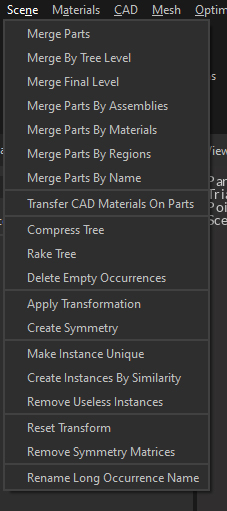Scene Menu

The Scene Menu contains the most commonly used functions to manage the Product Structure (tree), in order to optimize it.
NOTE Optimizing the Product Structure can be very beneficial to limit the number of draw calls and maximizing performances in the final staging tool (Unity for example), as less transformation matrices are computed.
|
Menu option |
Description |
Keyboard Shortcut |
|
Merges all selected Parts together, as one single Part (assembles a collection of parts into a single resulting part) |
|
|
|
Reduces the Product Structure (Tree) depth by merging together all Parts located at the specified Tree Level. The Tree Level designates the level at which an occurrence is positioned in the Tree (Root node is Level 0) |
|
|
|
Converts all final Assembly nodes of the selection into Parts by merging their children. A Final Level designates an Assembly node whose children are exclusively Part occurrences. |
|
|
|
Merges together into one Part all Parts contained under each Assembly node of the Product Structure |
|
|
|
For all materials, merges Parts of the selection by visible materials. The visible material is the material displayed on a polygon in the viewer (not necessarily the one set as a Material Property of the Part that owns the polygon: see About Materials). |
|
|
|
Merges parts together, based on their physical proximity in the scene, meaning by region |
|
|
|
Within a selection of Parts, merges together into one Part all Parts sharing the same name (identical "Name" property) |
|
|
|
All materials inherited from a parent node or from the CAD surfaces of a Part are transferred to the Material Property of this Part. This action is executed for each Part of the hierarchy. This makes the material management easier in Pixyz Studio. |
|
|
|
Compresses a sub-tree of the Product Structure (Tree) by removing empty nodes, or any node containing only one sub-node, and by removing useless instances |
|
|
|
Simplifies the Product Structure (Tree) by transferring all occurrences under the Root node of the scene (flattens all transforms) |
|
|
|
Deletes Assembly nodes without children (Empty) |
|
|
|
Used to change the transformation matrix of a selection |
|
|
|
Creates planar symmetry from a selection |
|
|
|
Destroys connection of a selected Instance with its other instances, making it unique (also called singularize) |
|
|
|
Creates instances when there are similar parts. This can be used to repair instances or to simplify a model that has similar parts that could be instanciated instead to reduce the number of unique meshes (reduces drawcalls, GPU memory usage and file size). Using 1.0 (100%) in all similarity criteria is non destructive. Using lower values will help finding more similar parts, even if their polycount or dimensions varies a bit |
|
|
|
Remove instances where they are not needed (prototype referenced once, ...) |
|
|
|
Sets all transformation matrices of the selection to identity |
|
|
|
Removes symmetry matrices, meaning negative scales, in order to avoid improper behavior in game engines for example (when applying physics, or for lighmaps generation). For symmetric occurrences having negative scales, a matrix is applied directly to the geometries. Careful as the rotation of the Pivot Point might have been altered in the process. |
|
|
|
Automatically reduces the character length in Assembly and Part name attribute to the specified value |
|